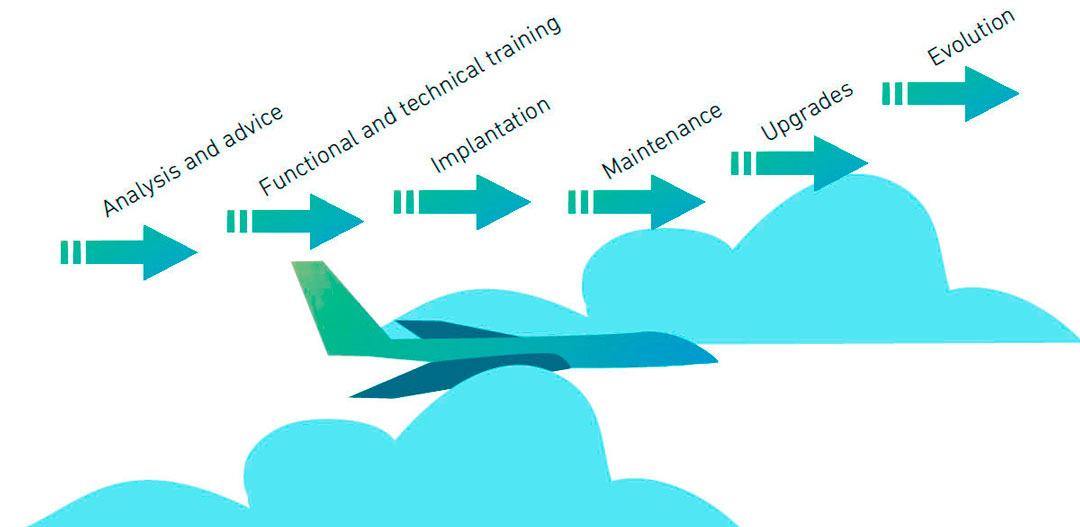Phases of ERP implementation
NaN-tic Jul 26, 2022
Would you embark on a company’s transformation with your eyes closed and a lot of blind trust? Absolutely not. And neither do we.
In order that you can be clear about how NaN-tic will help you successfully achieve the implementation of the ERP you need, in this article we show the phases of an ERP implementation. For this, we have had the expertise of our senior consultant Carlos Hilario, who has gathered specialized know-how and experience in the implementation of ERP for years in companies in different sectors of activity.
-
Disembarkation
The preparations, getting to know each company thoroughly, defining the project and the resources. -
Focus
We already have focused on the Why and the What, and we have foreseen risks, opportunities, and challenges. -
Action Plan
Now we agree on the How, When, and Who. -
Implementation
Hands to work with construction, training, moving, and start-up. -
Evaluation
Evaluations after the start and transition to the next step.
C arles Hilario Sanz is a senior consultant at NaN-tic, where he has been responsible for ERP implementations, customizations, and process improvement during the last ten years.
arles Hilario Sanz is a senior consultant at NaN-tic, where he has been responsible for ERP implementations, customizations, and process improvement during the last ten years.
His previous background in commercial and marketing departments provided him with a customer-oriented vision in project management that he has continued to enhance.
The phases of the implementation of the ERP that we will describe below are the result of this knowledge acquired with the experience of the implementations carried out.
We start at the beginning when our consultants take the project.
1. Disembarkation
Knowing your organization widely, who you are, what you do, the most important goals, global objectives, and objectives that are expected with the ERP, in addition to the people who make up the company, is the most important thing for us in this first step. Knowing the client and the project deeply is our priority to achieve what the company needs.
The team of NaN-tic consultants who will manage the Tryton ERP implementation project is made up of a senior consultant and an executive consultant, and in a first meeting, how we manage the process and the different roles within the project are explained.
As the Tryton ERP is a modular business management tool with many functionalities, to get the most out of its flexibility and robustness, it is necessary that consultants know in detail the reasons for the business transformation, or for the change if another ERP is already installed.
With this information, the objectives of the ERP implementation can be clearly defined, so as not to lose sight of the fact that transformation is not the goal but the means. That is, we want to install an ERP because we have specific needs to be covered.
We also take into account that a company technology such as an ERP is not implemented without evolving the work of people. The implementation of an ERP is the digital transformation from the root of the company.
In this first phase, the following are established in the most feasible way and with tangible terms:
-
Objectives, with maximum transparency to correctly manage expectations.
-
Functionalities that will be implemented, from the indispensable modules at the start to those that will be joined later.
-
Need for tailor-made improvements or standard implementation.
-
Definition of project expenses.
-
Key interlocutors and users of the project.
-
Feasibility and transfer of data from the previous system.
-
Training for users.
-
Limiting factors of the project: functionalities, calendar, investment, etc.
Important note: do not detract from the importance of the training of people, is key to the success of the implementation and therefore NaN-tic offers a very extensive training web platform, and makes a start-up simulation to solve deficiencies in the knowledge of the use of the ERP.
2. Focus
Once the needs have been discovered and the functionalities and resources explained, the organization has already defined the objectives of the ERP implementation, the risks, opportunities, and challenges with the support of the consultants. We continue with the second phase of the ERP implementation.
ERP objectives and functionalities
What the company wants to achieve with the ERP will dictate which Tryton functionalities you want to install. From finance, accounting, and invoicing to production control, logistics, and transport, through business intelligence or project management... Tryton offers a wide range of functionalities to respond to the restlessness of the company. You can have a sample asking us for a demo and also have more information at Tryton ERP.
Risks and opportunities of ERP implementation
Organizations can sometimes have operational blocks and concentrate on these blocks, this is a very common risk and in which many ERP features are lost of sight, which enables different ways of focusing on the objectives, and provides solutions that the company had not contemplated before. Here begins an effect of opening the focus, from the detail to the panorama, a very useful opportunity for the company.
Another risk is that fear of changes may appear in people, which ends up resulting in resistance (passive or active). The implementation of ERP is not only a technological transformation of the company, but it is also a transformation in the daily workflows of people, and changes awaken concerns of all kinds. That is why the task of the consultant, in addition to providing tools, analyzing needs, designing the most appropriate ERP configuration, and managing the process; is also a task of accompaniment of people in a complex transformation process, which is never easy, and which means an operational and personal change of individuals in the organization. This risk is at the same time a great opportunity for transformation according to a professional world that is transforming at a high speed today.
The other risks that we want to mention but they depend on each company, are that users are not sufficiently trained on the day of the startup, or that there are limiting factors of timing or budget to be able to get everything you want and when you want. Everything is talked about in meetings with consultants to plan in detail and with transparency.
Challenges for the company and for NaN-tic!
The main challenges for the company have to do with the viability and transfer of data and user training. Here there will be a lot of work that will be added to the work that people already do daily. A company cannot stop its day-to-day by the acquisition of an ERP and what it takes to implement it.
Therefore, people will have to make an additional effort to be able, on the one hand, to deliver to NaN-tic the data that the system requires to function (databases), and in addition, for this data to be viable must be delivered in a certain way.
On the other hand, finding the time and energy to train. And this point is very important to training users that’s why NaN-tic offers a training platform with all the functionalities of Tryton. And also the support of the executive consultant to solve the doubts that may arise in the use of the ERP. If users do not know enough about using the tool on the day of the boot it would be, without exaggeration, a disaster. Fortunately, NaN-tic performs boot simulations to test whether users are ready or not.
The main challenges for NaN-tic are related to the configuration of the customized ERP. Based on standard tools offered by the Tryton ERP, the executive consultant, with the supervision of the senior consultant, will build the web platform that the client will use with the functionalities that he has requested (menus, automated reports, invoices, delivery notes, notices, legislations, etc.). If in addition, as users test the ERP with demos and training, tailor-made improvements needs are emerging, for which programming is required, the challenge is greater.
Without a doubt, the global challenge is completely shared, it is human and organizational. Implementing an ERP is not a flat path but it is worth it from all points of view.
3. Action Plan
In the third phase of ERP implementation, the following are defined and agreed:
-
The workflows required by the boot.
-
The grouping of these flows by topics in consulting sessions.
-
The consulting agenda with the company's project manager.
-
Creation of the planning that must be approved by the company.
On the part of the company, it was necessary to have the managers of the departments involved, the general manager, the key users, and a project manager. The key users are those people who will be the final users, but these people do not have the bird's eye view that managers have on how different operations affect the overall performance of the company. That is why it is important that in the action plan stage you work with key people and with managers at the same time. A project manager by the company is very useful to act as a bridge between the needs of key users and the managerial vision.
Important note: the most effective way to transform an organization is to make people feel part of the transformation, in this way you can manage the anxiety that can cause relearning to do the work with a new tool or the fears of losing "status" within the team. When people's fears are discovered, you have the clues to sustain them and make them part of the change.
4. Implementation
We enter into the most operational phase of ERP implementation. At this point, NaN-tic can already create the environment where the modules will be installed, implement the ERP and develop customized improvements if there are any. On the part of the company, they have a web training tool to learn how to use the ERP and must perform the tasks required for the preparation of the data and its migration. Thus begins a very close collaboration between the company and the executive consultant, and in the event that there are tailor-made improvements, also with the NaN-tic programmer assigned to the project.
It is from the beginning, an intense work of communication and accompaniment of people and will be throughout the process. Although the executive consultant is the main interlocutor on the part of NaN-tic in this phase, the senior consultant will supervise all the actions that are completed to detect the deviations that occur and adjust the project to the continuous changes that are ground in this type of transformations of a company.
Before the boot, there will be simulation sessions to check that everyone is ready for change. And there will also be tests on the operation of the new ERP. Even so, the start of a new ERP is a moment of intense work that can stress and that tests all the work done, but it is overcome with the good support of the expert consultants of NaN-tic and the great effort of the people of the company.
The culmination of this fourth stage is the boot.
5. Evaluation
Once the start-up is done, the process is evaluated based on the planning. At this point, the phases of the ERP implementation are finished. The company then moves on to the next much simpler state of maintenance with the support of the NaN-tic Support team. From this moment it opens:
-
Maintenance and support to the user.
-
A process of continuous improvement to incorporate or polish functionalities of the program.

Do you need an ERP? We are the expert and close team you need, do not hesitate! Contact us.
If you want to know the opinion of our customers you will find it in: What our customers say.

